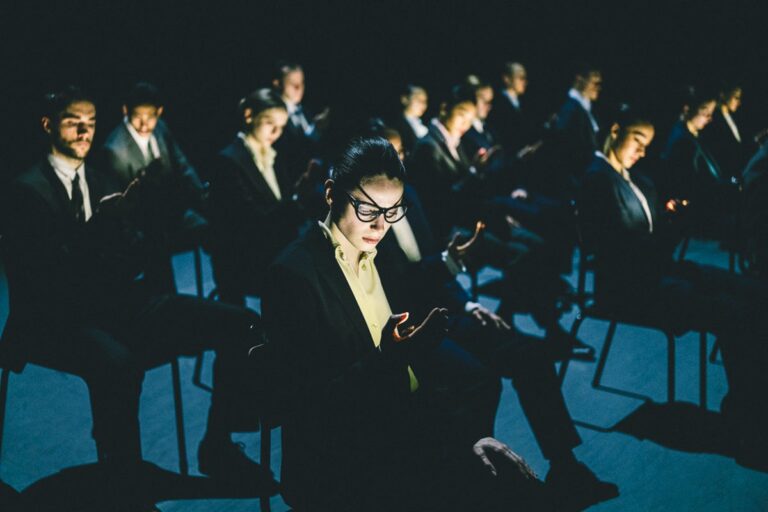Who wants to watch another show about the climate emergency? That’s the question actor and playwright Simon McBurney (Tinker Tailor Soldier Spy, Jane Eyre) and choreographer Crystal Pite (Betroffenheit, Revisor) asked themselves when they decided to collaborate on a project in 2020. The topic felt “urgent and necessary”, but the pair knew audiences were bored to tears of being lectured about Earth’s impending destruction. And so they opted instead to give theatregoers a space to “gather and feel” our communal sense of loss and powerlessness that runs alongside the worsening climate crisis. “It’s easy to have a constant sense of outrage,” says Pite. “Curiosity and earnestness are far more motivating.”
The result is Figures in Extinction, a three-act production four years in the making. It won the Zwaan dance award when the first act premiered in the Netherlands in 2022 and the Sky Arts Dance Award when it debuted in its entirety in the UK this year. This week, the production will begin a sold-out run at London’s Sadler’s Wells theatre. It’s fair to say Pite and McBurney’s sentiments resonated with audiences. “It’s my greatest hope that we’ve created the right conditions in the theatre for people to connect with each other and have an opportunity to reflect,” says Pite. “It’s different from activism or protest… We wanted the audience to feel held and embraced by the show, as much as they might be confronted by it.”
.jpeg)
Act one “Figures in Extinction 1.0” comprises dancer portraits of the flora, fauna and natural phenomena to have recently become extinct due to human intervention: a glacier, a school of fish, a Bachman’s warbler bird, a caribou herd. “It’s a kind of on-stage catalogue where we name and number what we’ve lost – and the list is knowingly incomplete,” says Pite of the choreography, performed by Nederlands Dans Theatre, to an overlapping crescendo of the species names read aloud by McBurney. The dancers, clad in elaborate wildlife costumes by Nancy Bryant, personify these lost species with increasing urgency and momentum as the names pile up. “It’s about our separation from the living world,” McBurney says. “And at the same time our human grief in the face of that loss,” Pite adds.
The second act “Figures in Extinction 2.0”, meanwhile, focuses on humans – asking the question why we do what we do. Notably, in between choreographing the triptych’s first piece and its second in 2024, the war in Gaza began. “That came into the room,” McBurney says. “You can’t talk about what’s going on in the world without asking, ‘Why are we doing this? Why is this happening?’” A lecture given by Scottish philosopher Iain McGilchrist on his 2009 book The Master and His Emissary: The Divided Brain and the Making of the Western World, which investigates these very questions, became the stimulus for the show’s second act, with audio of McGilchrist’s lecture remixed over the piece. “Most of the time we believe the things we do are our decision,” McBurney explains of McGilchrist’s theory. “What we don’t think about is our vast inner life… the unconscious, prompting us to do things. What prompts the unconscious? The world that we live in.”

Quite rightly, Pite’s first question was: “How the heck do you make a dance out of that?” But then she came across a quick line drawing cartoon by the Royal Society of Arts that animated McGilchrist’s ideas. “The content, rhythm and texture of it was fascinating,” says Pite. “I was able to imagine how I could illustrate Iain’s ideas through choreography. He’s our narrator and our guide – but the dancers take turns embodying his voice, giving his voice a body. There’s a lot of verbal language in the piece and theatrical magic we work with on stage, too – but what I do as a dance artist is translate ideas into the body.”
If Figures in Extinction part one is about our separation from the living world and part two follows our disconnect from the intuitive mind, Pite and McBurney felt our detachment from the dead would be an apt conclusion. “For me, that’s something that’s very urgent,” says McBurney, who interviewed the dancers about people they’d lost and their family histories in order to create “constellations” of their genealogy, audio of which plays over speech improvisations recorded by actors from McBurney’s theatre company Complicité. By the time he’d charted the entire group, the whole map of the world was covered, exemplifying the interconnectedness of us all – living and dead. “We tend to think the dead don’t really exist,” McBurney says. “In fact, everything is working together, isn’t it?”
Separation is the conduit that runs through Figures in Extinction. “But if separation is the question, then connection is surely the answer,” Pite says. “I think you can feel a yearning for connection that runs through the whole performance. Certainly, our show was not meant to provide certainty or solutions to the world’s problems – or even affect change… It’s an exercise of both doubt and hope.” Hopefully, she adds, “it might offer some solace and an invitation to think collectively together in the beautiful and earnest way that humans can do really well – especially in theatre.”
Figures in Extinction is on at Sadler’s Wells Theatre from 5 to 8 November


